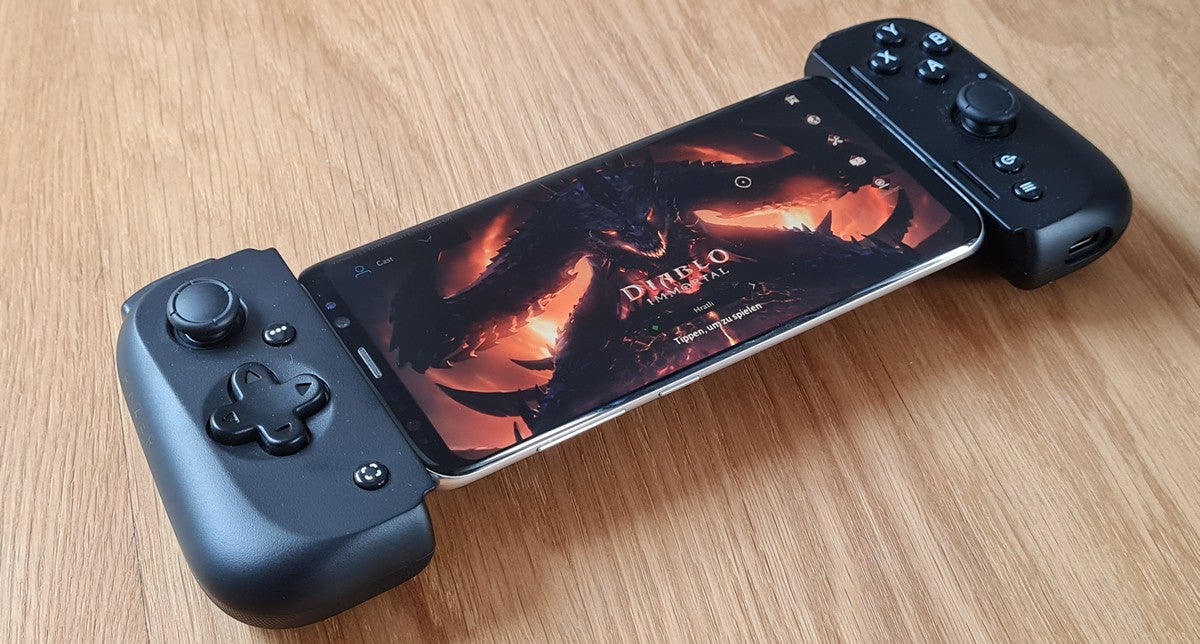Razer has released the second version of its mobile gaming controller Kishi and promises some improvements in various areas. The Android version of the Razer Kishi V2 is already on the market, and a version for iOS is scheduled to follow this fall. The controller, which also serves as a holder for your smartphone, costs you a whopping 119.99 euros. Is he worth it?
A difficult question, especially since normal gamepads, such as the Dualsense of the PlayStation 5, can also be connected to a smartphone and are much more attractively priced. The Kishi V2 offers the advantage that the smartphone rests comfortably in the middle of the controller, the structure is ultimately reminiscent of a switch.
Structurally, the overall design of the Kishi V2 feels a bit more compact and less bulky than the Kishi, which benefits mobility and, if you ask me, looks better visually. As usual from the predecessor, you pull both sides apart and place your smartphone on the USB-C connector in the middle. The sides then pull together magnetically and the smartphone is held securely in place by rubber attachments. At least if you keep it normal while playing. If you’re throwing the controller around out of frustration, I can’t guarantee anything.
The Kishi V2 does not have its own battery
As mentioned, you plug your smartphone directly into the integrated USB-C connector of the Kishi V2. This also means that your device should of course be a bit more modern and have such a port in order to be able to use it with this. The direct connection via USB ensures that all inputs are transmitted without major delays.
However, unlike the Nacon MG-X Pro, the Razer Kishi V2 does not have its own battery. It only works and can only be switched on as soon as a smartphone has been connected via USB and is powered by it. Using the USB-C port on the Kishi V2, you can also charge your cell phone while playing, if you want to or the power is running out.
Good buttons but the noise!
By default, the Kishi V2 is equipped with a row of buttons. There are two clickable analog sticks, a mechanical D-Pad, four standard buttons, two triggers and two bumpers and two multifunction buttons next to them. Also, we have menu and option buttons, a share button, and a launch button for the Razer Nexus app.
Basically, the keys also feel good and implement the inputs precisely, regardless of whether they are buttons or the stepless triggers. The downside is the clicking noise that pretty much all of the buttons make. This is reminiscent of a mouse button and is rather annoying in the long run when playing, especially if you have to hammer on the keys regularly depending on the game. The use of headphones is also recommended.

The processing of the controller is clean and appears to be of high quality and stable for the price. At the same time, it’s still primarily plastic, so don’t expect great use of premium materials. The handles are also textured on both rear sides and should provide a little more grip. In short: purely haptically, it feels good to use it.
Designed for Android games
Similar to using the Kishi V2, you can download the new Razer Nexus app onto your smartphone, which replaces the old Kishi app. Among other things, it is possible to assign a function to the two assignable buttons next to the shoulder buttons. But these are the only keys that can be assigned. Xbox users must take into account that none of the buttons on the Kishi V2 replace the Xbox button. Instead, you have to use this function via the touch screen to end a game, for example.
But back to the app. You can also activate streaming and start a live stream from the app, for example on YouTube or on Facebook. If you wish, you can use one of the buttons to record videos and screenshots directly, the app is used for administration. And another function: you can use it as a game launcher. In the app you can see installed games and others that are 100 percent compatible with the Kishi V2. Good for getting an overview.
Razer Kishi V2 Review – Conclusion
In a direct comparison, the MG-X Pro from Nacon actually appeals a little more than the Kishi V2. On Razer’s device, the clicking noises of the buttons bother me in the long run. Whoever came up with this idea, it wasn’t a good one. Equally annoying, but quite negligible, is that none of the buttons activate the Xbox menu when using Xbox streaming and I also have to use the touchscreen for this. A criticism that you can ignore if you don’t do Xbox streaming.
Apart from that, the Razer Kishi V2 does its job well, is stable and of high quality and your inputs are reliably transferred to the game. However, the price is not exactly cheap at 119.99 euros, especially compared to the competition, which is also better attuned to Xbox streaming. If you primarily play Android games and swear by Razer, the Kishi V2 is definitely a good choice.
The post Razer Kishi V2 Review – Easy to play on mobile, but the clicking is annoying appeared first on Gamingsym.
